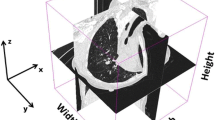Abstract
Electromagnetic navigation bronchoscopy (ENB) uses electromagnetic positioning technology to guide the bronchoscope to accurately and quickly reach the lesion along the planned path. However, enormous data in high-resolution lung computed tomography (CT) and the complex structure of multilevel branching bronchial tree make fast path search challenging for path planning. We propose a coordinate-based fast lightweight path search (CPS) algorithm for ENB. First, the centerline is extracted from the bronchial tree by applying topological thinning. Then, Euclidean-distance-based coordinate search is applied. The centerline points are represented by their coordinates, and adjacent points along the navigation path are selected considering the shortest Euclidean distance to the target on the centerline nearest the lesion. From the top of the trachea centerline, search is repeated until reaching the target. In 50 high-resolution lung CT images acquired from five scanners, the CPS algorithm achieves accuracy, average search time, and average memory consumption of 100%, 88.5 ms, and 166.0 MB, respectively, reducing search time by 74.3% and 73.1% and memory consumption by 83.3% and 83.0% compared with Dijkstra and A* algorithms, respectively. CPS algorithm is suitable for path search in multilevel branching bronchial tree navigation based on high-resolution lung CT images.
Graphical Abstract






Similar content being viewed by others
References
Liu F, Li J, Guan Y et al (2019) Dysbiosis of the gut microbiome is associated with tumor biomarkers in lung cancer. Int J Biol Sci 15(11):2381. https://doi.org/10.7150/ijbs.35980
Luo YH, Luo L, Wampfler JA et al (2019) 5-year overall survival in patients with lung cancer eligible or ineligible for screening according to US Preventive Services Task Force criteria: a prospective, observational cohort study. Lancet Oncol 20(8):1098–1108. https://doi.org/10.1016/S1470-2045(19)30329-8
Tang Y, Qiao G, Xu E et al (2017) Biomarkers for early diagnosis, prognosis, prediction, and recurrence monitoring of non-small cell lung cancer. OncoTargets Ther 10:4527. https://doi.org/10.2147/OTT.S142149
López-Encuentra A, García-Luján R, Rivas JJ et al (2005) Comparison between clinical and pathologic staging in 2,994 cases of lung cancer. Ann Thorac Surg 79(3):974–979. https://doi.org/10.1016/j.athoracsur.2004.06.004
Eberhardt R, Anantham D, Herth F et al (2007) Electromagnetic navigation diagnostic bronchoscopy in peripheral lung lesions. Chest 131(6):1800–1805. https://doi.org/10.1378/chest.06-3016
Bao F, Gu Z, Wang R et al (2021) P02. 17 Feasibility and safety of ENB guided microwave ablation for lung cancer: a preliminary report. J Thorac Oncol 16(3):S253–S254. https://doi.org/10.1016/j.jtho.2021.01.365
Nelson G, Wu M, Hinkel C et al (2016) Improved targeting accuracy of lung tumor biopsies with scanning-beam digital x-ray tomosynthesis image guidance. Med Phys 43(12):6282–6290. https://doi.org/10.1118/1.4966025
Hautmann H, Schneider A, Pinkau T et al (2005) Electromagnetic catheter navigation during bronchoscopy: validation of a novel method by conventional fluoroscopy. Chest 128(1):382–387. https://doi.org/10.1378/chest.128.1.382
Bitter I, Sato M, Bender M et al (2000) CEASAR: a smooth, accurate and robust centerline extraction algorithm. In: Proceedings Visualization 2000. VIS 2000 (Cat. No. 00CH37145) pp. 45–52. https://doi.org/10.1109/VISUAL.2000.885675
Geng H, Yang J, Tan W et al (2014) Fast 3D skeleton extraction of airways and applications to virtual bronchoscopy. In: The 26th Chinese Control and Decision Conference (2014 CCDC) pp. 3879–3884. https://doi.org/10.1109/CCDC.2014.6852857
Wan M, Liang Z, Ke Q et al (2002) Automatic centerline extraction for virtual colonoscopy. IEEE Trans Med Imaging 21(12):1450–1460. https://doi.org/10.1109/TMI.2002.806409
Lee TC, Kashyap RL, Chu CN (1994) Building skeleton models via 3-D medial surface axis thinning algorithms. CVGIP: Graph Model Image Process 56(6):462–478. https://doi.org/10.1006/cgip.1994.1042
Paik DS, Beaulieu CF, Jeffrey RB et al (1998) Automated flight path planning for virtual endoscopy. Med Phys 25(5):629–637. https://doi.org/10.1118/1.598244
Palágyi K, Kuba, (1998) A 3D 6-subiteration thinning algorithm for extracting medial lines. Pattern Recognit Lett 19(7):613–627. https://doi.org/10.1016/S0167-8655(98)00031-2
Law TY, Heng PA (2000) Automatic centerline extraction for 3D virtual bronchoscopy. In: International Conference on Medical Image Computing and Computer-Assisted Intervention pp. 786–793. https://doi.org/10.1007/978-3-540-40899-4_81
Dijkstra EW (1959) A note on two problems in connexion with graphs. Numer Math 1(1):269–271. https://doi.org/10.1007/bf01386390
Ciobirca C, Lango T, Gruionu G et al (2018) A new procedure for automatic path planning in bronchoscopy. Mater Today 5(13):26513–26518. https://doi.org/10.1016/j.matpr.2018.08.109
Hart PE, Nilsson NJ, Raphael B (1968) A formal basis for the heuristic determination of minimum cost paths. IEEE Trans Sys Sci Cybern 4(2):100–107. https://doi.org/10.1109/tssc.1968.300136
Homann H (2007) Implementation of a 3D thinning algorithm. Insight J 421:1–4. https://hodad.bioen.utah.edu/devbuilds/biomesh3d/FEMesher/references/ITKbinaryThinningImageFilter3D.pdf. Accessed 19 Mar 2021
Zhao XY, Wang X, Xia W et al (2020) A cross-modal 3D deep learning for accurate lymph node metastasis prediction in clinical stage T1 lung adenocarcinoma. Lung Cancer 145:10–17. https://doi.org/10.1016/j.lungcan.2020.04.014
Silversmith W. Dijkstra3d [Internet]. GitHub; 2018. Available from: https://github.com/seung-lab/dijkstra3d. Accessed 21 Nov 2021
MeasureAlgoTime. GitHub; 2018. Available from: https://github.com/peng1ei/MeasureAlgoTime. Accessed 25 Nov 2021
Process Status API (PSAPI) [Internet]. Microsoft; 2021. Available from: https://docs.microsoft.com/en-us/windows/win32/api/psapi/. Accessed 25 Nov 2021
Morita Y, Yamashiro T, Tsuchiya N et al (2020) Automatic bronchial segmentation on ultra-HRCT scans: advantage of the 1024-matrix size with 0.25-mm slice thickness reconstruction. Jpn J Radiol 38(10):953–959. https://doi.org/10.1007/s11604-020-01000-9
Heutink F, Koch V, Verbist B et al (2020) Multi-Scale deep learning framework for cochlea localization, segmentation and analysis on clinical ultra-high-resolution CT images. Comput Meth Prog Bio 191:105387. https://doi.org/10.1016/j.cmpb.2020.105387
Funding
This work was supported by the Key Research and Development Program of Jiangsu under Grant BE2021663; the National Natural Science Foundation of China under Grants 81871439, 61801474, and 61801475; Iran National Science Foundation under Grant 96003954; and the Shandong Province Department of Science and Technology under Grant ZR2020QF019.
Author information
Authors and Affiliations
Corresponding author
Ethics declarations
Competing interests
The authors declare no competing interests.
Additional information
Publisher's note
Springer Nature remains neutral with regard to jurisdictional claims in published maps and institutional affiliations.
Supplementary Information
Below is the link to the electronic supplementary material.
About this article
Cite this article
Wu, W., Xia, W., Jun, Z. et al. Coordinate-based fast lightweight path search algorithm for electromagnetic navigation bronchoscopy. Med Biol Eng Comput 61, 699–708 (2023). https://doi.org/10.1007/s11517-022-02740-8
Received:
Accepted:
Published:
Issue Date:
DOI: https://doi.org/10.1007/s11517-022-02740-8




